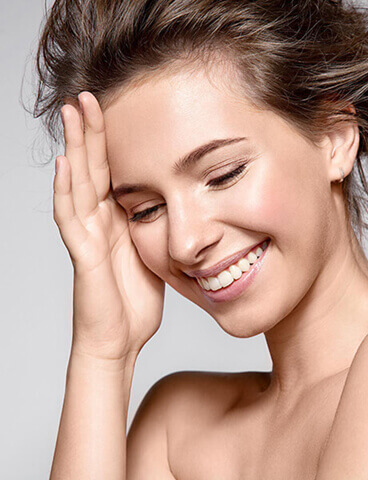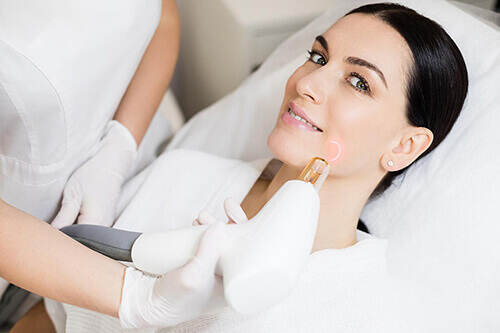
As we age, our faces and necks undergo changes that can make us look a lot older than we feel. The skin loosens, the lines of the jaw and neck lose their definition, and jowls or a double chin may form as tissues start to sag. If you’re bothered by these or other signs of aging, such as pronounced lines between your nose and mouth, you may be a candidate for facial rejuvenation.
Facial rejuvenation can mean a full or partial face lift, fat grafting, liposuction, laser treatments, or a combination of procedures. Modern techniques yield natural-looking results that are a far cry from the pulled-tight look of face lifts in the past. A consultation with Dr. Jensen will help clarify what’s appropriate for you, based on your own anatomy and skin as well as your personal goals. Every facial rejuvenation plan needs to be designed to meet the specific needs of the individual.
Eyelid surgery—blepharoplasty—is considered a separate procedure, though it may be done in combination with facial rejuvenation.
Face Lift
Called “rhytidectomy,” face-lift surgery involves making incisions at the edge of the face to re-sculpt underlying tissues and tighten facial muscles. The skin is repositioned over the newly lifted facial contours, smoothing wrinkles, and excess skin is removed.
A traditional full face-lift is the most comprehensive and cohesive approach to facial rejuvenation, addressing all parts of the face and also the neck. By addressing both areas at the same time, a completely harmonious appearance can be assured. Another incision may be needed below the chin to deal with neck issues.
Gravity, sun damage, and heredity often combine to make the neck one of the first places to show aging. Loose skin and fat below the chin can create a “turkey wattle” effect, jowls, or a double chin. The youthful angle of the neck may be lost, and you may look larger than you really are. Face lift surgery can correct this by tightening and elevating the neck muscles and eliminating excess skin and fat.
Sometimes liposuction is done at the same time as a face lift, or fat transfer may be utilized to fill in features that have lost their fullness.
A face lift will be most effective for those whose skin still has some elasticity. The surgery usually takes between two and four hours, depending on whether other procedures are being carried out at the same time. Face lifts are done on an outpatient basis under general anesthesia.
Results and Recovery
A face lift won’t stop the normal aging process, but usually the results of a full face lift last for years. It’s important to use sun protection to prolong the effects.
Following a face lift, bandages are applied to minimize swelling. Medication is prescribed to deal with any discomfort, which is usually not significant. Swelling, bruising, tenderness, and temporary numbness are normal. You’ll want to treat your skin gently and get lots of rest, and to avoid strenuous activity for at least two weeks. Most patients can return to work in two or three weeks.
The results of a face lift will become obvious as the swelling and bruising decrease, though the swelling may not be completely gone for several months. The scars, which will fade over time, will be concealed in your hairline and the natural lines of your face and ears.
What are the Risks?
As with any surgery, complications can occur, though they’re not typical. Potential risks include bleeding, infection, nerve damage (usually not permanent), unfavorable scarring, a lack of symmetry, hairline changes, and the possibility that additional surgery may be needed.
What Does it Cost?
The cost of a face lift includes fees for the surgeon, anesthesia, and facility as well as any medications that may be needed. Insurance plans will not cover face lift surgery. At the time of your consultation with Dr. Jensen, you will be given a price quote for the specific procedure you are considering.
Lower Face Lift
You may not be in need of a full face lift but feel unhappy about aging in the bottom part of your face. In this case, a lower face lift may be all that’s required. The basic process is the same as for a traditional facelift, but the incisions are shorter and the surgeon manipulates only the tissues and skin of the cheeks and lower face. This can be effective for eliminating jowls, raising the cheeks and the corners of the mouth, and smoothing deep wrinkles.
Neck Liposuction
When excess fat is part of the problem, liposuction may be carried out along with a face lift or a laser face lift. For younger patients with good skin elasticity, liposuction alone may be successful for streamlining the angle of the neck. Those who have significant skin folds will experience better results with a face/neck lift.
Fat Injections
Faces lose their youthful roundness with age, and the resulting “sunken” appearance can make one look perpetually tired. Fat transfer is a way to counteract this. With this technique, fat cells harvested by liposuction from one part of the body—such as the abdomen, thighs, or buttocks—are re-injected where they are needed to fill out the face. This might be around the cheeks, under the eyes, or in the lips.
The small needles used to graft the fat leave no visible scarring. The results are subtle and natural looking, and while noticeable bruising and swelling can be expected for a week or two after the procedure, most patients experience minimal discomfort. Fat transfer can be performed by itself or as a component of a more extensive facial rejuvenation plan.
Laser Face Lift

Laser technology provides a nonsurgical way to deal with surface facial imperfections such as fine lines and age spots. A laser beam is used to remove the top layer of skin, causing the collagen underneath to tighten and stimulating the formation of a new, smoother skin layer. The process is minimally invasive, requiring no stitches and leaving no scars. (See Laser Treatment.)
A laser face lift treats just the skin surface; it doesn’t correct jowls or remove folds of loose skin. The best candidates are lighter-skinned individuals, since darker skins may be more susceptible to pigmentation changes as a result of laser treatment.
Some skin soreness and “weeping” can be expected for several days, followed by a bright pink or reddish skin color that will fade over the following weeks or months. Laser treatments won’t stop the natural aging process, though the skin will be smoother than it would have been otherwise. Many individuals choose to repeat the process in a few years.





